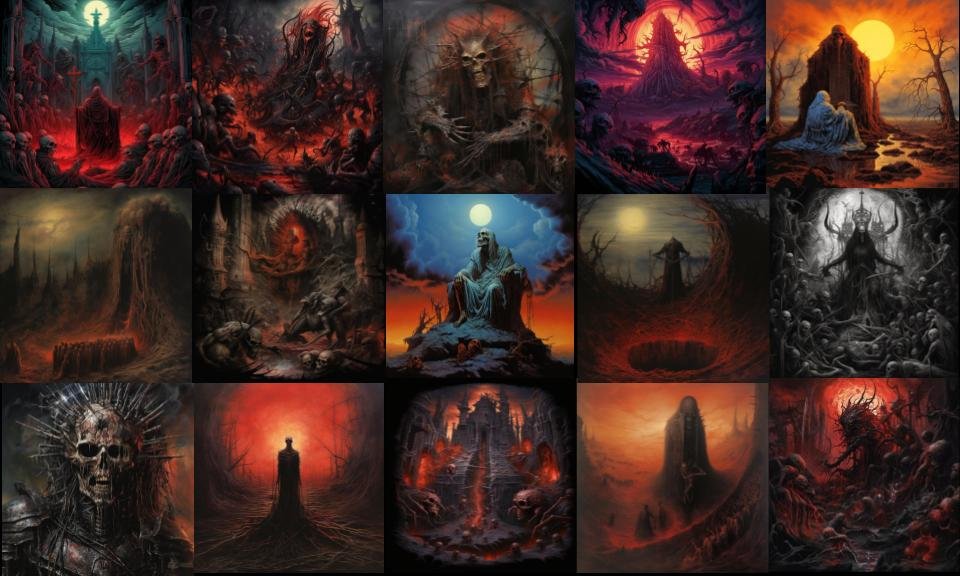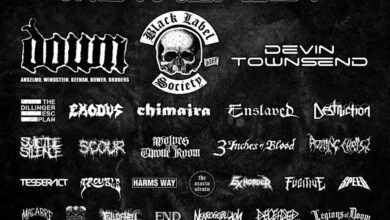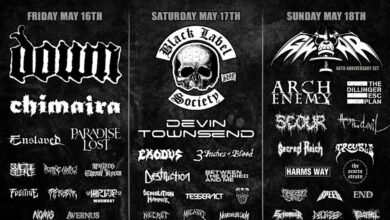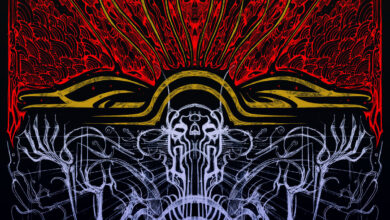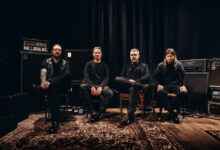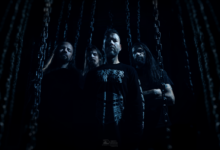Rare is the moment when one first encounters the haunting visage of a death metal album cover – that singular instant where grotesque magnificence and artistic brutality converge to create an indelible impression upon the psyche. These dark canvases, evolving from their primordial roots in shock-driven imagery, now stand as towering monuments to extreme artistic expression, demanding scholarly discourse and critical contemplation.
Death metal’s visual lexicon has undergone a profound metamorphosis through the decades, transforming from raw, visceral brutality into a sophisticated artistic movement that commands reverence in the hallowed halls of fine art establishments. These macabre masterworks, once confined to the underground’s shadowy corners, now grace prestigious galleries and museums, their intricate architectural nightmares and baroque horror-scapes challenging conventional artistic boundaries. This exploration shall navigate the tempestuous waters of extreme metal artistry, unveiling the masterminds who craft these dark vessels of visual expression, decoding their labyrinthine symbolism, and illuminating how they have carved an indelible mark upon the face of contemporary extreme music culture.
The Evolution of Death Metal Visual Esthetics
Deep within extreme metal’s abyssal depths, death metal’s visual language charts a remarkable odyssey from its horror-cinema origins toward the refined shores of sophisticated artistic expression. Like ancient mariners mapping uncharted waters, the genre’s visual identity remains forever anchored to its horror-cinema roots [3].
From Horror to High Art
Transcending the tempestuous waters of mere shock value, death metal artwork now commands respect in hallowed artistic circles. The genre’s nascent period witnessed unholy alliances between bands and graphic artisans, forging brutal, distinctive pieces that would pierce through the underground’s murky depths [3]. These dark collaborations birthed countless iconic covers, their influence rippling through decades of extreme metal culture.
Color Theory in Death Metal Artwork
Scientific exploration into metal’s chromatic depths reveals fascinating patterns lurking beneath the surface. A comprehensive study of 1,150 metal album artworks illuminates death metal’s predilection for shadows, its artwork dwelling in significantly darker realms than non-metal counterparts [3]. The genre’s dominant palette manifests through:
- Black and dark gray tones, commanding the visual landscape
- Brown and orange hues, particularly prevalent in groove metal’s territories
- Purple and deep red accents, hallmarks of traditional death metal’s domain [3]
These chromatic choices emerge not from arbitrary depths but stand scientifically tethered to primal emotions – agitation, anger – and sonic characteristics like distortion and heaviness [3].
The Impact of Digital Design
The significant shift in death metal artwork during the mid-to-late 90s heralded a new epoch, as digital technologies cast their shadow over traditional design paradigms [4]. This technological leviathan brought both boundless possibilities and existential challenges to the genre’s visual identity. While some artists embraced these digital depths, others remained steadfast in their dedication to traditional craftsmanship, creating a fascinating duality in modern death metal aesthetics.
The genre’s visual evolution surges forward, relentless as ocean currents. Contemporary artists incorporate surrealist elements and fine art techniques into their work, crafting abstract symbolic narratives while maintaining death metal’s essential darkness [4]. This transformation echoes not merely technological advancement but bears witness to death metal’s artistic maturation.
Legendary Artists Behind the Brutality
Towering figures emerge from death metal’s artistic pantheon, their creations etched forever into the genre’s collective consciousness. These visionary craftsmen forge nightmarish realms that transcend mere album artwork, becoming portals to darker dimensions of human experience.
Dan Seagrave‘s Architectural Nightmares
Dan Seagrave stands as death metal’s architectural prophet, his sprawling landscapes of twisted stone and ancient temples redefining the boundaries of extreme metal’s visual language [5]. Each masterwork pulses with meticulous detail, conjuring vast tableaux of greed, isolation, and human depersonalization [6]. Between 1988 and 1994, this dark virtuoso birthed forty monumental works [7], among them:
- Altars of Madness – A spiraling vortex of tormented visages, wrought through weeks of obsessive detail
- Like an Everflowing Stream – A haunting glimpse into civilizations lost to time’s abyss
- Effigy of the Forgotten – A six-week descent into mechanical madness, where feral machines writhe through corrupted landscapes [8]
Ed Repka’s Grotesque Vision
Ed Repka emerges as death metal’s paradoxical prophet – an artist who, while standing apart from the genre’s sonic assault [9], has carved some of its most defining visual monuments. His masterful renderings of nuclear devastation and decomposing flesh established thrash metal’s visual vocabulary [5]. Repka’s oeuvre manifests as a dark fusion – exploitation cinema’s raw power merged with political commentary and B-movie horror’s primal appeal [10].
Modern Masters of Macabre
A new epoch dawns as contemporary visionaries push death metal artwork toward unexplored horizons. These dark architects blend ancestral techniques with digital sorcery, honoring tradition while charting bold new territories. Denis channels Beksiński’s otherworldly visions into abstract horror landscapes, while Pavel conjures photorealistic nightmares through digital alchemy [2].
These modern prophets of darkness continue expanding death metal’s visual lexicon, their works bridging traditional craftsmanship and technological innovation. Their creations stand as testament to death metal artwork’s evolution from underground phenomenon to legitimate artistic expression, each piece a window into realms where beauty and brutality become one.
Symbolic Elements in Death Metal Artwork
Beneath death metal’s visceral exterior lies an intricate labyrinth of symbolic elements, each corridor revealing profound artistic statements that transcend mere shock value. These dark tableaux harbor manifold meanings, their shadowy depths shaping the very essence of extreme metal’s visual identity.
Religious and Occult Imagery
Death metal’s communion with religious imagery traces its lineage to Black Sabbath’s primordial influence, architects who first carved occult symbolism into metal’s visual bedrock [11]. The genre’s symbolic vocabulary has evolved into a vast cathedral of meaning, spanning from raw anti-Christian proclamations to nuanced spiritual explorations. Contemporary artists weave:
- Theological paradoxes through stark visual dialectics
- Arcane mystical sigils and occult hieroglyphs
- Perverted religious iconography, twisted into new forms
Gore and Violence as Artistic Expression
Gore isn’t merely about shock value – it manifests as a sophisticated artistic dialect speaking profound truths about human nature [12]. These crimson canvases serve as mirrors reflecting societal decay, each wound a metaphor for civilization’s deeper afflictions. Cannibal Corpse’s notorious artwork stands as a blood-soaked monument to the subgenre’s unflinching confrontational spirit [13].
Hidden Meanings and Easter Eggs
Careful examination reveals cryptic messages and veiled references lurking within death metal’s visual architecture [14]. These concealed elements manifest as:
| Type of Hidden Element | Purpose |
|---|---|
| Self-referential imagery | Creating connections between albums |
| Occult symbols | Deepening thematic elements |
| Literary references | Adding intellectual depth |
These symbolic elements form an arcane language understood primarily by the genre’s devoted adherents [15]. Artists weave subtle references through their work like dark threads in a tapestry, revealing their true nature only to those who dare to look deeper. Each viewing unveils new layers of meaning, creating an experience as intricate and multifaceted as the music itself.
Most compelling is the transformation of these symbolic elements from mere provocations into sophisticated artistic declarations. Modern death metal artwork achieves a precarious equilibrium between repulsion and allure [12], employing classical artistic principles to elevate even the most extreme imagery into the realm of high art.
Technical Mastery in Cover Design
Beneath death metal’s shadowy veneer lies a realm of exacting craftsmanship, where artistic vision crystallizes through meticulous execution. The genre’s visual evolution reveals a dark tapestry woven with precise technical mastery, each thread carefully placed to maximize its impact on the viewer’s psyche.
Typography and Logo Design
Death metal’s typographic evolution charts a course from legible simplicity to labyrinthine complexity. These modern hieroglyphs, with their gothic-inspired architecture and asymmetrical letter forms [16], serve as portals to darker realms. The genre’s most compelling logos manifest through:
- Savage, textured strokes carved like ancient runes
- Ethereal, gothic flourishes reminiscent of forgotten cathedral spires
- Metallic embellishments that gleam with predatory intent
Composition Techniques
The architecture of death metal artwork reveals carefully orchestrated visual hierarchies. Early specimens featured intricate artwork with vibrant colors, their detailed illustrations serving as windows into nightmare realms [4]. Modern compositions often employ singular dominant hues, allowing secondary colors to lurk in shadowy contrast [6]. These dark canvases serve multiple masters:
| Purpose | Implementation |
|---|---|
| Setting Tone | Creates immediate atmosphere |
| Visual Identity | Establishes band recognition |
| Thematic Support | Reinforces musical concepts |
Digital vs Traditional Methods
The digital revolution has carved new paths through death metal’s artistic landscape. While traditionalists like Dan Seagrave conjure nightmares through hand-drawn precision, contemporary dark artists traverse multiple realms. Digital prophets like TIMUR maintain classical techniques in the digital sphere, forging what they term ‘digital ink’ style [2].
This evolution breeds both innovation and discord. While some bands remain anchored to traditional methodologies, others embrace digital sorcery [4]. The most compelling modern works often arise from this confluence of old and new – digital precision enhancing rather than supplanting traditional craftsmanship. This unholy union preserves death metal’s characteristic intricacy while harnessing technology’s dark potential for precision and reproducibility.
Cultural Impact and Controversy
Death metal’s visual lexicon stands perpetually poised upon controversy’s razor edge, its provocative artworks simultaneously challenging societal norms and reshaping artistic boundaries. These dark canvases, born from extreme metal’s depths, now cast long shadows across contemporary culture’s landscape.
Censorship Battles
The genre’s visual assault has weathered countless storms of censorship and moral panic. Major retailers like Walmart and Kmart have consistently refused to stock albums with explicit artwork [17], forcing artists to navigate treacherous waters between artistic vision and commercial viability. Consider these battles fought in censorship’s arena:
| Band | Album | Censorship Action |
|---|---|---|
| Cannibal Corpse | Butchered at Birth | Banned in Germany until 2006 [18] |
| Slayer | Christ Illusion | Recalled and destroyed in India [18] |
| Guns N’ Roses | Appetite for Destruction | Original artwork replaced [19] |
Influence on Popular Culture
Death metal’s artistic influence now reaches far beyond its underground origins, its tentacles extending into diverse creative realms [20]. This dark aesthetic has infiltrated:
- Fashion’s avant-garde and streetwear’s rebellious spirit
- Contemporary art’s hallowed gallery spaces
- Cinema’s visual vocabulary and gaming’s digital realms
- Graphic design’s evolving paradigms
Academic circles now scrutinize these works with scholarly intensity [20], examining their role as catalysts for personal catharsis and societal discourse. These pieces transcend mere shock value, becoming powerful vehicles for social commentary while maintaining their artistic sovereignty.
Collector’s Perspective
Within collecting circles, death metal’s visual artifacts have ascended to near-mythical status. These pieces command reverence beyond their musical foundations, with rare and controversial editions becoming coveted treasures [21]. Original pressings bearing censored artwork metamorphose into valuable relics, their worth measured in both monetary and cultural currency.
These dark masterpieces serve as multifaceted jewels in collectors’ crowns, simultaneously functioning as:
- Historical documents of extreme art’s evolution
- Testaments to artistic mastery
- Artifacts of print craftsmanship
- Controversial cultural touchstones
- Investment vehicles of growing value
Death metal’s visual legacy continues its relentless evolution, transcending its origins as mere provocation to achieve status as legitimate cultural artifact. Despite perpetual censorship battles [17], these works maintain their artistic integrity while pushing boundaries ever outward. The genre’s visual language now permeates modern cultural discourse, its influence reaching from haute couture to academic dissertation [20].
Conclusion
Death metal’s visual legacy stands eternal – a dark chronicle of artistic metamorphosis that has transcended its origins in shock and horror to emerge as a sophisticated form of creative expression. Through shadowed corridors of time, visionaries like Dan Seagrave and Ed Repka have carved monuments of darkness, while modern digital architects continue expanding the boundaries of this macabre art form.
These dark tableaux weave intricate narratives through labyrinthine symbolism and masterful technical execution, each piece a window into realms where beauty and brutality dance in eternal embrace. Despite weathering storms of censorship and controversy, death metal artwork now commands respect in contemporary art’s hallowed halls, its influence reaching from fashion’s avant-garde to fine art’s sacred spaces.
Like the sonic tempests it accompanies, death metal artwork forces viewers to confront uncomfortable truths lurking beneath civilization’s polished surface. Those who would dismiss these works as mere provocation fail to perceive the profound artistic statements lying in wait, each piece demanding serious critical discourse. These dark masterpieces shall continue their reign, challenging perspectives, igniting passionate debate, and inspiring future generations of artists who dare to navigate the extreme edges of visual expression.
References
[1] – https://overgroundscene.wordpress.com/2018/05/30/is-this-where-i-came-from-13-horror-cinema-and-death-metal-album-covers/
[2] – https://all4band.com/death-metal-album-art
[3] – https://intellectdiscover.com/content/journals/10.1386/mms_00095_1
[4] – https://metalcover.art/the-evolution-of-death-metal-album-artwork/
[5] – https://www.kerrang.com/the-15-greatest-metal-cover-illustrators-of-all-time
[6] – https://metalinjection.net/sick-art/killing-art-exploring-old-school-death-metal-album-covers
[7] – https://www.voicesfromthedarkside.de/special/dan-seagrave/
[8] – https://www.decibelmagazine.com/2016/03/23/top-5-dan-seagrave-covers-of-1991/
[9] – https://en.wikipedia.org/wiki/Ed_Repka
[10] – https://excusetheblood.wordpress.com/2021/04/26/the-apocalyptic-and-satirical-art-of-ed-repka/
[11] – https://www.loudersound.com/features/satan-death-mutilation-and-murder-why-are-heavy-metal-album-covers-so-scary
[12] – https://www.heaviestofart.com/post/behind-the-cover-necrot-mortal
[13] – https://www.themetalpit.org/the-art-of-the-metal-album-cover/
[14] – https://ultimateclassicrock.com/album-cover-easter-eggs/
[15] – https://mediarep.org/bitstreams/b18dacdd-3464-4b6a-8620-787be1f25e0b/download
[16] – https://www.pttrns.com/most-iconic-death-metal-fonts-for-album-art/
[17] – https://www.ranker.com/list/controversial-album-covers/christopher-shultz
[18] – https://metalinjection.net/lists/10-of-the-biggest-metal-album-cover-controversies
[19] – https://www.kerrang.com/20-album-covers-that-were-banned-or-censored
[20] – https://www.atmostfear-entertainment.com/editorials/extreme-metal-arts-exploring-musical-visual-cultural-significance/
[21] – https://metal-album.design/the-art-of-metal-how-heavy-metal-album-covers-transcend-music/

